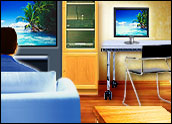
The set-top box (STB) is the primary point of entry into the digital home for television services, including cable TV, DTH (Direct to Home satellite), and IPTV (Internet protocol television). This device has evolved beyond its historical role as a simple black box sitting on top of a large TV set into a smaller form-factor device supporting a variety of functions, notably interactive television applications. Service providers worldwide are aggressively upgrading their equipment to support the migration away from analog television and toward digital television (DTV), with the hopes of improving consumer satisfaction and creating service differentiators.
In markets with a high penetration of DTV subscriptions, support for advanced features such as VoD (video on demand), DVR/PVR, and other interactive applications are driving the deployment of digital STBs. Another interesting development has been a resurgence in the concept of a residential gateway (RG), which is a complex device capable of delivering multiple services to the home, including video, data, voice and wireless. This development seems to set up competing hardware paradigms, with two different form factors expanding their roles, with functional overlap, within the home. Right now, there is no clear industry consensus about whether, and to what extent, STB functions will shift to the residential gateway or vice versa.
Gateway Your Way
Currently both telcos and cable operators are setting up their infrastructures to support sophisticated RGs. A versatile gateway, once deployed, allows the operators to deploy multiple services without having to invest incremental CAPEX, meaning they can add additional revenue streams by leveraging existing hardware. In addition, by retaining the RG within their domain, operators can manage the install and activation processes in a way that minimizes their support costs both during and after deployment.
This development, however, will limit the number of retail options for consumers. RGs capable of delivering multiple services into the digital home will require a considerable amount of integration with an operator’s back-office resources and support systems. As a result, certifying multiple third-party CE devices for service delivery would be an expensive proposition for operators, so they will likely want to steer consumers away from these options.
Instead, consumer choice will be among providers, and carriers will compete for each subscriber, motivated by the promise of new and expanding revenue streams. Parks Associates’ consumer research reveals interest in the concept of connected consumer electronics is high, definitely high enough to justify up-front deployment costs.
Additional Fees May Apply
Consumers are particularly interested in set-top boxes that link to multiple sources, including television offerings from their service provider, content on their home PC, and content streaming from the Internet. Perhaps more interesting — at least according to a service provider’s desire to create new revenue streams — is the percentage of consumers willing to pay additional fees each month for a feature that can pull content from a variety of sources. The percentage of consumers willing to pay up to US$5.99 per month for such an offering is comparable to the known adoption rate for Verizon’s Home Media DVR feature, which includes a multiroom DVR and networked set-top box. Verizon charges FiOS TV subscribers an additional $4 per month for this benefit.
When Parks Associates asked consumers what features they would find valuable from a connected set-top box, the ability to stream music is the top application. Not too far behind is the ability to access e-mail and customized weather. Watching YouTube videos is a relatively less popular application, but over time, consumers will refine their interests in this new service category. Soon they will be demanding well-organized and easily accessible premium content services, and service providers will be able to use these kinds of services to differentiate from the competition.
Laying the Foundation
This differentiation will also open a path for service providers to extend their reach further into their subscribers’ homes. They want to tap into the promise of higher ARPU that comes with blended applications, and their market strategies, which include digital television at the core of the bundle, will drive the design of and demand for set-top boxes. Already the TV service market is highly competitive, with the global digital transition and new video distribution channels like DTT (digital terrestrial television), IPTV, and over-the-top video services pushing carriers to higher levels of service.
Provided operators put the correct hardware in place, they can take advantage of connected consumer electronics over time to launch home networking, online storage, remote DVR scheduling, and other types of advanced services. Providing managed digital home services will be a differentiating factor for service bundles and could grow into a major revenue generator. This expansion of the service paradigm will cause the battle in the DTV field to spread to the entire service market for the digital home, the future bread-and-butter for incumbents and newcomers alike.
Based on these market forces, combined with the drive that comes with consumer demand, Parks Associates expects the role that a set-top box serves in the home to expand. Service providers, especially cable and telco/IPTV operators, will leverage this platform to support their multiplay strategies. Consequently, the set-top box will play a role as a home media server itself or as a network node, supporting multimedia functions and connecting multiple entertainment platforms while linking back to an RG to offer whole-home services.
Jayant Dasari is an analyst at Parks Associates.













































The idea of cable cos. offering a "Residential Gateway" and having a set-top-box as "the primary point of entry into the digital home" concerns me greatly! For this same reason I install a router between the ISP and my LAN. I want a demarcation point under my control…untangle.com offers an open source firewall which I believe is the best perimeter solution for the digital home.